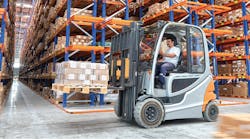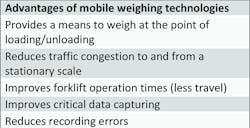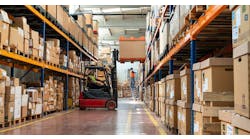The online shopping experience is changing our lives. We purchase online and expect our purchases to be at our door the next day. Companies like Amazon are leading the industry in satisfying this consumer expectation by developing a model that provides convenience and fast delivery to the consumer. What does this mean to the manufacturer of goods? The warehouses that store the goods? The transportation companies that move those goods to the consumer? The answer is simple—SPEED!
Mobile weighing technologies can help meet the emerging “need for speed” trend by providing a means of weighment at the point of loading and unloading. They do this while at the same time immediately communicating a wealth of specific business and logistical data, eliminating inefficient traffic patterns, and improving safety by reducing traffic congestion.
NEW TRANSPORTATION PARADIGM EMERGING
Warehouses, manufacturing and transportation companies are the leaders in adopting mobile weighing technology to respond to the new trend, in which every part of the logistical process requires a higher degree of processing—with more accurate information—than in the past. Tracking shipments and orders and maintaining visibility is no longer just a convenience—it is a requirement. Existing process are being replaced with more efficient processes that take less time, improve safety and deliver quickly.
Like many other areas of industry, the transportation sector is examining how the Internet of Things (IoT) can improve efficiency. We have been collecting data for years, but now manufacturers are letting machinery, equipment and processes start to take actions themselves. In other words, technology, processes and people are converging—and the facilities most affected are those that need to understand the product location, the status of the product, and where it is in the process.
What is needed are technologies that help companies move products faster through the process, know more about where they are in that process, and capture data to understand what is happening each moment. The information is also being used by owners who are looking to make better decisions on investing money on additional storage space and equipment.
WEIGHING TECHNOLOGY ADAPTS
In the past, the typical warehouse and manufacturing designs were developed using stationary (static) scales located in strategic areas within the facility. Operators relied on forklifts and pallet jacks to move product from the loading/unloading area to the scale, weigh the goods, and manually record information before returning back to the loading/unloading area.
Static scales can be a good option and will always have a place, especially if the product or material moving through the material handling system is cumbersome, or if there are awkward shapes. For example, if you are pouring hot molten steel, you might not want to move it around on a forklift, where it could slosh around and pose a safety hazard. With a stationery scale, end users always know where it is, making it easier to stay away from the hazard. In these cases a centrally located static scale meets the need of the material. In addition, static weighing provides a consistency of process because one person is running the equipment.
However, in today’s fast-paced environment, using a process based on a static scale has its limitations. It consumes valuable time and energy resources moving the goods to and from the scale, while producing traffic congestion in higher volume processes. And it just can’t keep up with today’s data requirements. Also, if a scale goes out of operation, everyone sits and waits for it to be fixed.
Wherever there is a demand and a need to satisfy a customer requirement for speed and decrease inefficiencies, users should evaluate mobile weighing technology, especially for weighing pallets, boxes, or other typical units.
Mobile weighing provides a means to weigh and capture critical data at the point of loading/unloading. Instead of securing a forklift and moving the product to a centrally located scale, the load is weighed on the pallet jack or forklift as soon as it is picked up, reducing time required to weigh and improving safety by reducing traffic congestion to and from a stationary scale, as well as improving forklift operation times.
In addition, critical process data can be captured at the pallet jack or forklift and communicated wirelessly to systems that track and measure the process. Information on the action is instantly communicated to critical systems. This reduces the time required to record critical process data. It also reduces human recording errors, with data flowing straight into a PDA or handheld device; users can even use Wi-Fi and communicate to the infrastructure in a building.
With a mobile forklift there is no travel time, which increases efficiency, reduces congestion and improves safety. If one mobile forklift goes down, others can continue. Since there will be multiple drivers, a higher level of up-front training may be needed to achieve the consistency you might get from having a single forklift driver, but that is a constraint that can be overcome. (One downside is that using the forklift for weighing ties up an asset that cannot be used for other processes.)
Here’s an example of the cost advantages of a mobile strategy for a medium-sized manufacturing facility. The company does about 40,000 pallet movements per year, of which about a fourth (10-12,000) must be weighed. The facility switched to a mobile fork scale, saving about 3 minutes per weighment, which amounted to about 620-man hours per year. At an average labor cost of about $35 per hour for a forklift driver, they achieved savings of about $1808 per month, or $21,696 per year. The scale cost about $8,000, plus about $500 per year in maintenance, for a total cost of $8500, resulting in total savings of $13,196 per year.
Another example is a large Southern grocery chain, which was looking for an alternative to tying up a forklift on a simple, single-layer produce weighing procedure for relatively lightweight products. In addition, a variety of computer equipment and cables were hanging from the forklifts, reducing the drivers’ line of sight and causing a potential safety issue. Having so many pieces of equipment was a maintenance challenge, so the company was seeking a simpler and more reliable solution.
They eventually selected a heavy-duty pallet jack scale that offered the company a rapid weight capturing method for its fast-moving, limited space environment that was cheaper, faster and more profitable. The mobile option also had a robust communication protocol.
WHERE ARE MOBILE WEIGHING APPLICATIONS HEADING?
Mobile weighing is used for a variety of industries, but is really coming on strong for moving pallets on cross-docks from shippers and then reorganizing the product to send out on trucking routes. Accurate weight information is useful for complying with regulatory weight and load requirements that affect how users load semi-trailers. There can be fines and citations if the weight is not spread out across the trailer so no one axle is overloaded—this helps roads last longer before repairs are needed. The mobile weighing products help end users load correctly; without proper knowledge of weights, they would have to pull back, tie up the loading dock, unload the products and try again to load the semi, which is wasteful and inefficient.
Mobile technology is also being used as a quality check for picking applications. For example, if a user is packing mufflers to send to a truck supply store, mobile weighing technology can be used to ensure the product is packed and shipped in the correct quantities and that the box weighs the right amount.
Future systems may contain voice activation or cameras that can take pictures to send to the end user or the next person in the chain of the process. This lets them know what is coming so they can make correct storage and unloading arrangements. These tasks may all be done with RFID or bar coding. The mobile weighing devices may also be integrated with wearables for picking; after an item is flagged and put on the device, the system could communicate to the customer that it has been put in the box and is ready to ship. While we are not there now, we are certainly well on the way.
One downside of today’s mobile weighing technology is that it does not yet address the issue of dimensional weighing, now being used by FedEx, UPS and other shippers. Dimensional weight reflects package density, which is the amount of space a package occupies in relation to its actual weight. Dimensional weight is calculated based on the length, height, width and weight of the package. The dimensional weight becomes the billable weight when the dimensional weight of the package exceeds its actual weight. End users need to know what is being shipped to ensure they are being properly charged. Dimensioning is currently being added to some mobile weighing products to meet this new requirement.
IMPLEMENTING A MOBILE WEIGHING TECHNOLOGY SYSTEM
The application of a good mobile weighing process centers on data collection. During the shipping process, users are not only weighing goods, they are collecting data and making decisions off the data on how goods are packed.
Start the implementation by conducting a thorough evaluation of what you are moving, where you are moving it to, and what data you need. Prove out the mobile strategy in small incremental steps. Prove each step and then move on to the next.
When you start the process, it is best to keep the existing scales, which can continue to serve as a backup. Often, the best strategy may be a combination of static and mobile weighing. Whatever strategy is pursued, safety is always the number one goal. Your implementation should consider if there are ways to improve safety using a mobile process.
Eeron Bergstrom is logistics industry manager with Fairbanks Scales, a manufacturer of weighing devices.




